| |
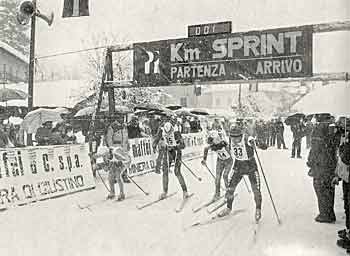
There are those who affirm that cross-country skiing was born between the Norwegian and Swedish hills while others insist that it came instead from the Siberian steppes. It’s an enigma that will always remain unresolved. Reliable testimony about two wooden curved sticks fixed to the feet and used for warlike operations and hunting excursions emerges only around the early part of the 11th century. Indeed, it is thought that Norwegian troops led by King Arald adopted skis in 1100: a decisive factor in the battle close to the city of Cristiania (Oslo today) helping to explain their victory against the hostile Danish army.
The sporting version of cross-country skiing does not however take shape until the 19th century, more precisely in 1814 when the first competitive sports display took place in the Norwegian capital. Important dates then followed one after another: in 1843 at Tromsöe the first official competition took place; in 1884 the first long-distance run (220km in length); in 1901 the first ski club of Italy was born in Turin and in 1913 the Italian Winter Sports Federation was founded in Milan.
The Dolomites region was one of the favourite destinations of early ski pioneers due to its special orographic features. Within our own province, the greatest enthusiasts were members of the Alpine Society of Trentino, established in around 1870. It was precisely in the last decades of the 1800s that group excursions into the Dolomites became more frequent, especially on the part of those who lived in the valleys.
We only hear of “skjatori” from Trentino in 1910. This was reported by the “Il Trentino” newspaper and referred to a journey made by several young men. Leaving from the establishment at Madonna di Campiglio, they managed to reach the summit of Spinale and were quite fascinated by the beauty of the panoramic views around them. Sticking with this locality, in 1913 it was also written that groups of Austro-Hungarian soldiers staying at the “Riva del Garda” fortress would arrive in Pinzolo. They would then climb up to Campiglio and engage in "recreation with skis”.
 
In those days there was no difference between cross-country skiing, ski mountaineering and Alpine skiing. The three disciplines came to be classified according to requirement: level plain, ascent and descent.
The first competitions (such as the legendary “Valligiani”) took place in the period straddling the two wars; however, the true cross-country skiing boom developed only at the end of the 1960s. This may have had something to do with the great endeavours of champions such as Federico and Giulio Deflorian and especially Franco Nones, of Castello di Fiemme, who in 1968 won the gold medal in the 30km event at the Grenoble Olympics. This was the spark which got the ball rolling: it stimulated awareness, widespread practice of the sport and a desire to better oneself. At the same time, the gaze of the North was attracted further by those great and legendary long-distance runs, of which the Vasaloppet (more than 90km in length) was the most iconic: the spotlight and the myth.
 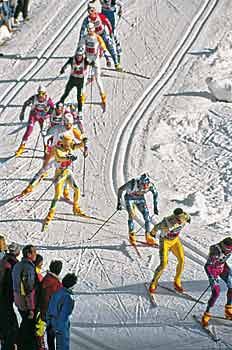 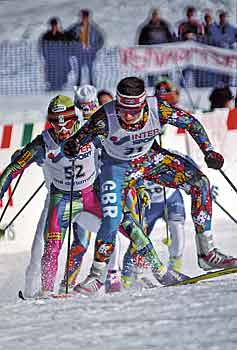
Even in Italy, the pioneers who returned enthusiastic and fascinated by the Vasaloppet were themselves harbouring thoughts of importing such an experience here as well, on our very own snow. So it was that the ball got rolling here too and set off a phenomenon that gathered momentum with impressive pace: today in Italy there are now almost 30 long-distance runs. Thus in 1970, thanks to the lawyer Franco De Pilati and the SAT Ski Club of Trento, it was agreed to launch a new and fascinating challenge: a long-distance race in Italy would now turn the dream into reality. 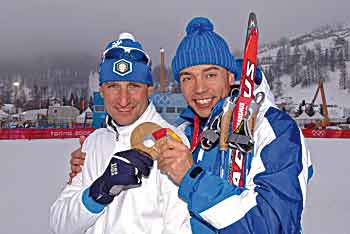 The first edition of “La Galopera” was seen in January 1971 at Viote on Mount Bondone. The following month, on the 7th of February 1971 to be exact, the “Marcialonga” appeared for the first time; its birth following the transfer to Scandinavia of the two “citizens” Roberto Moggio and Giulio Giovannini. It took place over a distance of 65 km and was won by Ulrico Kostner. In the years that followed, other long-distance runs were born including the Lavazèloppet on Passo Lavazé, the Millegrobbe on the Lavarone plateau in 1977, the Barba Trophy in 1972, as well as the Val di Sole Trophy, the Pilati Trophy and the Pinzolo 24 Hour Race. The latter was something of an anomaly, with a format comprising a medley relay of four athletes, who raced both by day and night. They were strongly supported by a few friends from the Val Rendena who were clearly very keen to host a major international competition in their valley too: Ezio Binelli, Ugo Caola, Diego Leoni e Toni Masè. The race took place over more than a decade at the centre of the Val Rendena, later migrating to Andalo before leaving the sporting calendar entirely. How could one forget the two editions of the world championships of Val di Fiemme in 1991 and 2003? There's a sense of anticipation that they might return, perhaps in 2013. The first edition of “La Galopera” was seen in January 1971 at Viote on Mount Bondone. The following month, on the 7th of February 1971 to be exact, the “Marcialonga” appeared for the first time; its birth following the transfer to Scandinavia of the two “citizens” Roberto Moggio and Giulio Giovannini. It took place over a distance of 65 km and was won by Ulrico Kostner. In the years that followed, other long-distance runs were born including the Lavazèloppet on Passo Lavazé, the Millegrobbe on the Lavarone plateau in 1977, the Barba Trophy in 1972, as well as the Val di Sole Trophy, the Pilati Trophy and the Pinzolo 24 Hour Race. The latter was something of an anomaly, with a format comprising a medley relay of four athletes, who raced both by day and night. They were strongly supported by a few friends from the Val Rendena who were clearly very keen to host a major international competition in their valley too: Ezio Binelli, Ugo Caola, Diego Leoni e Toni Masè. The race took place over more than a decade at the centre of the Val Rendena, later migrating to Andalo before leaving the sporting calendar entirely. How could one forget the two editions of the world championships of Val di Fiemme in 1991 and 2003? There's a sense of anticipation that they might return, perhaps in 2013.
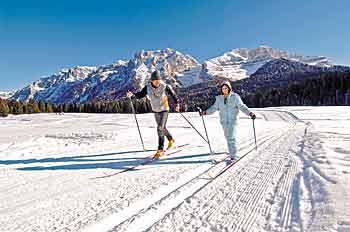 Recently cross-country skiing has changed radically, with all the elements in place for it to further establish its dominance. Just think of the technology and hard work that went into the Italian team at the Turin Olympics, hard work which also yielded superb results: first with the medley relay of Cristian Zorzi, a worthy heir to that other “Trentino” Giorgio Vanzetta, and then with Di Centa, winner of the 50km event. Recently cross-country skiing has changed radically, with all the elements in place for it to further establish its dominance. Just think of the technology and hard work that went into the Italian team at the Turin Olympics, hard work which also yielded superb results: first with the medley relay of Cristian Zorzi, a worthy heir to that other “Trentino” Giorgio Vanzetta, and then with Di Centa, winner of the 50km event.
The coming winter is also rich in promising events for the region. Above all, there’s the cross-country ski world cup on 5th and 6th January at Val di Fiemme and the Marcialonga on 27th January 2008.
The latest aspect is the ever-growing attention that the world of tourism is giving to cross-country skiing. Tourism companies in recent years have been developing the idea of spontaneous holiday packages linked to cross-country skiing, such as “Fitness in nature”. For those seeking an active holiday with complete freedom there’s nothing to match the appeal of cross-country skiing: total immersion in nature and a well-balanced form of physical exercise. That's especially the case in Trentino where there's a whole series of attractive initiatives in place: these include the Nordic Skipass, a special permit that allows access to no less than 17 cross-country zones.
Cross-country skiing has found its ideal location in the Dolomites. It’s not often that one gets the chance to enjoy this great discipline in an environment recognized as one of the natural wonders of the world.
- La marcialonga. foto Flavio Faganello
- 24ore Pinzolo
- Giulio Deflorian
- Galopera
- Cristian Zorzi in testa al gruppo
nella Coppa del Mondo della Val di Fiemme
- Marcialonga, 1995. foto P. Orler Dellasega
- foto M. Benedetti
- Zorro e Vanzetta,Torino2006. Photo Elvis
- Sci di fondo a Campiglio. foto Carlo Baroni
|
|
